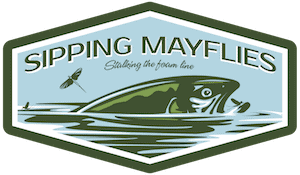Winter Fly Fishing Tips
[When, Where, and How]
Feb. 28th, 2022
Winter fly fishing doesn’t have to be frustrating. On the contrary, done correctly, your flies will catch a surprising number of trout during the cold winter season, which we’ll define as December, January, February, and March.
I go fly fishing once or twice per week during the winter, and its one of my favorite times of the year due to the added challenge, and the lack of crowds.
In this article I’m going to give you 19 of my proven winter trout fishing tips, including when and where you should focus your efforts. I’ll also cover the best winter fly patterns and the gear I don’t leave home without during the cold season. I’ll finish up with some thoughts on winter fly fishing safety.
I’ll even show you pictures of what midges and blue winged olives look like, the main cold season river insects.
Here’s a picture of a nice winter rainbow trout I caught in December on a size-20 blue winged olive dry fly.
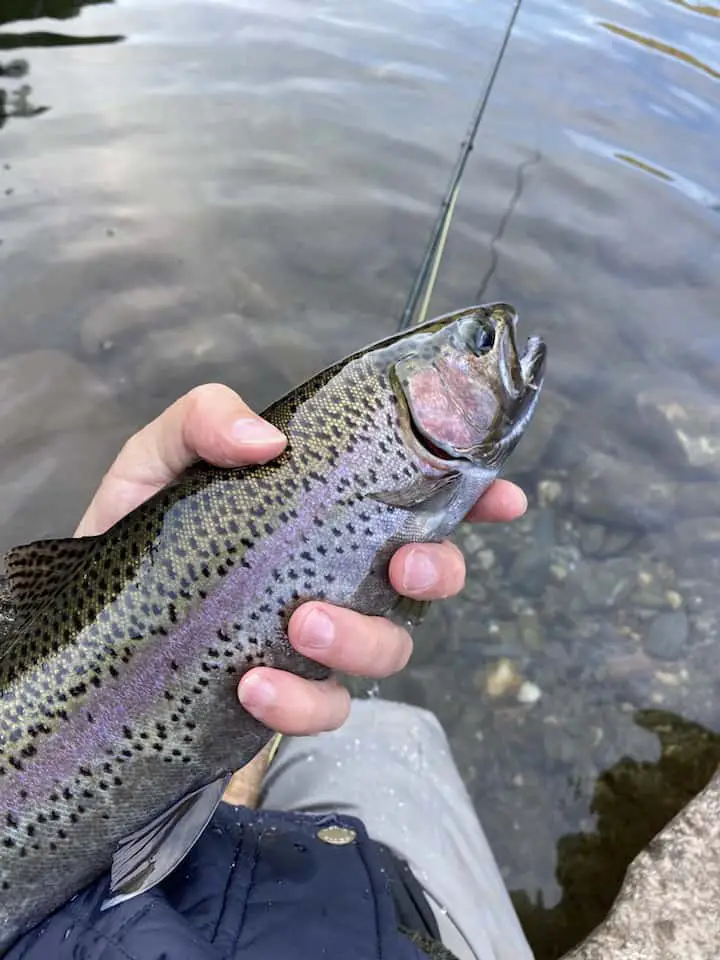
Can you fly fish in the winter?
Yes, you can fly fish during the winter, and it can be some of the most exciting fishing of the year. Cold-tolerant midges and blue winged olives will hatch throughout the wintertime, making it possible to catch trout even in frigid temperatures. Dry flies and nymphs are the ticket from December through March.
Here’s another nice winter rainbow trout I caught on a beadhead soft hackle pheasant tail nymph while there was still ice on the water.
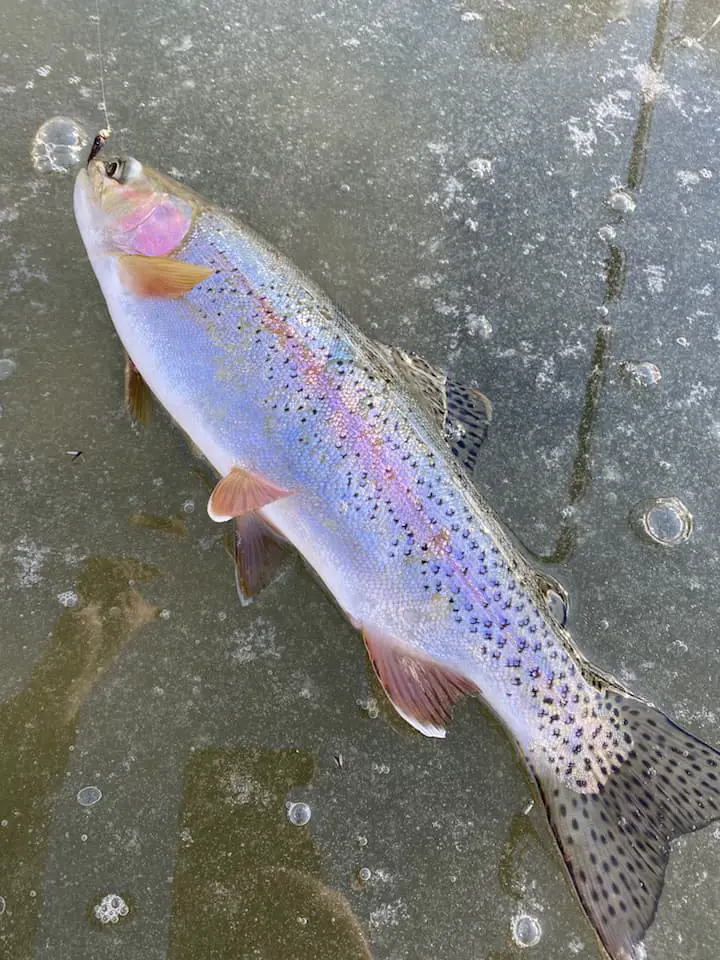
Winter Fly Fishing Tips and Tactics
- Slow things down. Remember, winter trout never stop eating–they can’t or they’ll die. But, their activity and metabolism slows down. This means they don’t want to chase things, they instead want the fly right on their nose, or at least very close. So, don’t strip streamers as quickly as you would during the summer.
- Bugs still hatch during the wintertime–namely blue winged olives (BWOs) and midges. These hatches generally occur almost every day. These are the insects you should focus on from December through March, the traditional winter season.
- When nymphing, use a fluorocarbon leader/tippet not only because fluorocarbon is stronger than monofilament, but because the low, clear water that winter can bring means fish won’t see your line quite as easily. Don’t use fluorocarbon when you’re casting dry flies.
- Regurgitated conventional wisdom in fly fishing will say that winter is a sub-surface game. This is well intentioned but misleading advice. I spend the vast majority of my time casting dry flies during winter and have a lot of success (more on this later).
- Move more slowly along the river because the water flows are lowest during this season and it can be easier to spook fish. You tend to see plenty of fish along the shoreline as well.
- One of my favorite winter tactics is to use one size lighter tippet than you’d ordinarily use. For example, if you generally use 5X, drop down to 6X. The thinner tippet material will make your line slightly less visible to the fish. This is also a great strategy when you’re using dry flies because the slower current means the trout will have more time to examine your offering. Every advantage helps.
- Regular floating fly line is ideal whether you’re dry fly fishing or using nymphs.
- When using dry flies, focus on smaller sized patterns. For example, you’ll almost always want to stay within the fly sizes of 18-24. Personally, I use dry flies sized 20-24 almost exclusively during the winter. Using lighter tippet, as I mentioned, will make tying-on tiny flies much easier.
Here’s an athletic brown trout I caught on a size 22 midge dry fly in February. You can see the ice in the background. Look at the size of that tail. Here’s an article I wrote on brown trout fly fishing you may want to check out.
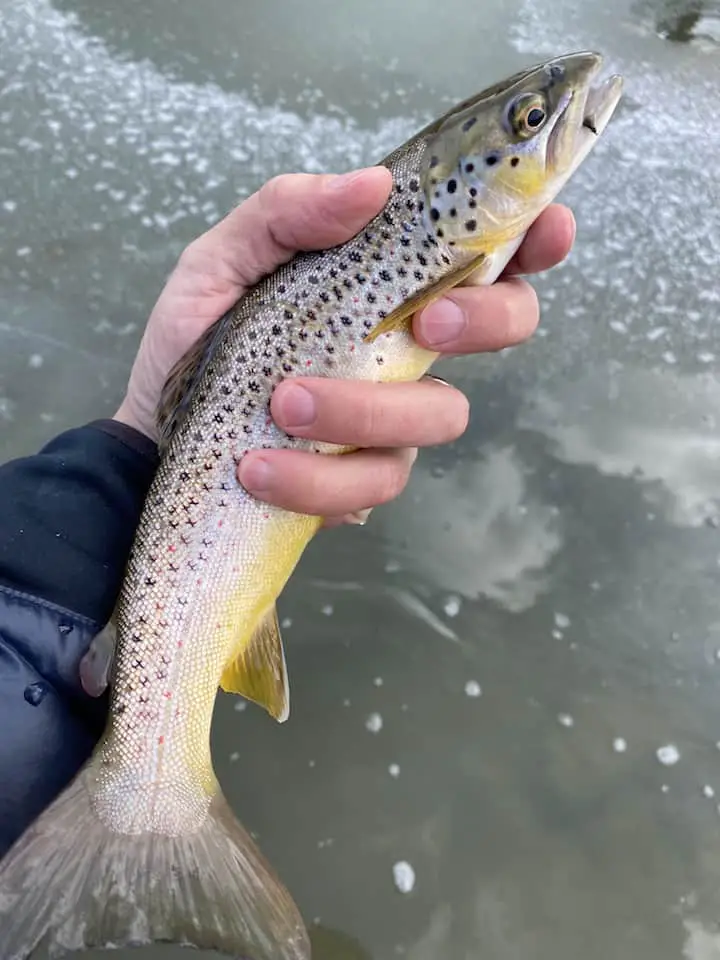
- When nymphing, if you’re not getting caught-up on the bottom of the river every few casts, you’re not deep enough. Add some split shot, use heavier nymph, or increase the distance between your indicator and nymph–or all of the above.
- When you inevitably get ice on your fly rod guides, try holding your rod underwater for a few seconds and then jiggling your rod in the air. This works sometimes. Sometimes it doesn’t. The other thing you can do is use Stanley’s ice-off paste from Loon Outdoors.
- Takes can be very subtle during the winter. Well, they can be anytime, but especially during the winter when trout are slower. Set the hook often. Hooksets are free.
- The winter sun rides lower in the sky, and this means it casts longer shadows onto the water. Make sure you’re always aware of where your shadow is cast, and make sure it’s not over the fish because they’ll spook.
- Be quiet and avoid fast movements on the river. Fish tend to pod-up in the lower water volume (flows are usually lowest during winter) and when you find a good spot, you can hunker down and spend a lot of time there. One recent January day, I spent five hours fishing the same tiny riffle, and caught trout throughout the duration.
- Concentrate on areas where fast water bumps up against slower water. These seams hold trout. Fish your flies on the slower side.
- The colder it gets, the smaller your dry flies should be.
Here’s a stout brown trout I caught on a tiny size 24 midge fly pattern in very early March. It was a slow run with some boulders in the mix. Trout were rising to adult midges on the water.

Tips on Where to Fly Fish in Winter
- Focusing your winter trout fishing efforts on tailwaters is your best bet. Tailwaters are rivers that are below a dam (ie. fed by a reservoir). The reservoir’s water is usually relatively constant year-round, and as a result tailwaters can have substantially “warmer” water during the winter (when compared to a freestone river, which is a river that’s not fed by a damn). This means more hatches and more active trout.
- Always carry a water thermometer, regardless of the season. I keep one clipped to my slingpack. Ideally, you’ll want to find winter water temperatures at or above 39F. Most of the tailwaters I fly fish during winter hover around 40F-45F from December through March. Water temperatures lower than 39F mean the fish will be even less active, making fly fishing more challenging.
- Spring creeks (streams fed by a spring) can also have relatively constant water temperatures throughout the year, making them ideal spots to focus on for winter fly fishing.
- If possible, avoid snowmelt-fed waterways. They can be very cold, and for the reasons I mentioned above, there are better areas to target.
- Avoid fast water. Focus on slower water. Fish won’t be holding in fast water, and they don’t want to chase your fly.
- If you want to increase your chances of a successful day, focus on slow riffles, runs and pools. Skip the pocket water, since it’s the least productive during winter in my experience.
- This is another favorite winter tactic of mine. In the below picture, you can see an ice sheet extending across part of the river. I took this picture because there were trout rising just off the edge of it. The reason is that trout like to hold underneath the ice, using it as cover. Use it to your advantage.
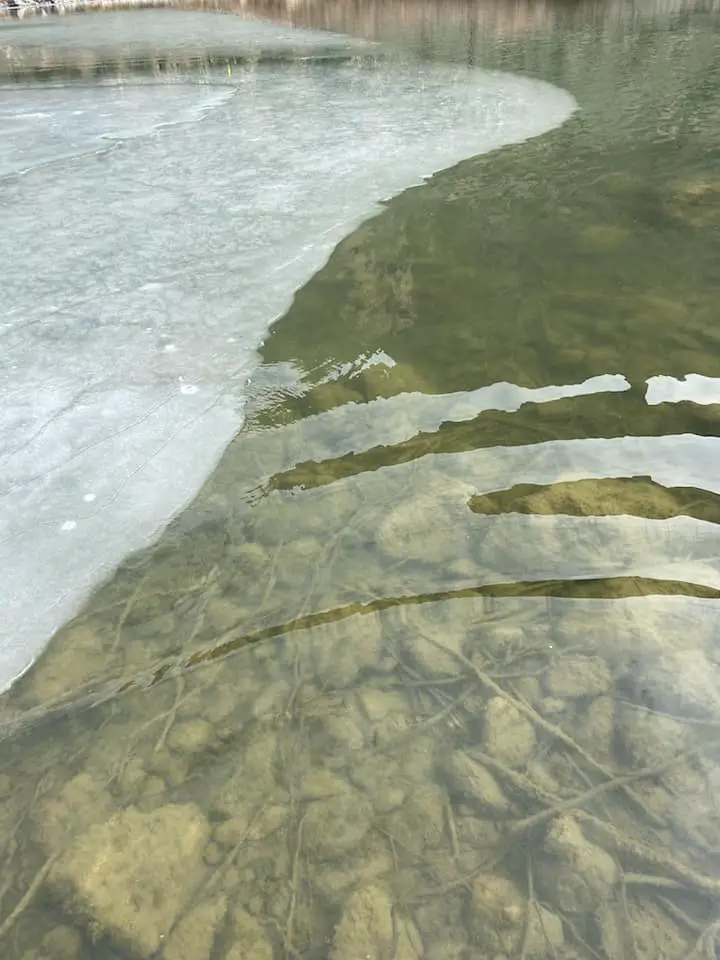
- Fishing for winter trout tends to be more productive in the western states such as Montana, Oregon, Idaho, Utah, California, and Colorado. But, don’t forget about Arkansas.
The Best Rivers for Winter Fly Fishing
There are innumerable rivers and streams that are excellent winter trout fishing destinations, but here are a few of the best known spots.
Utah – Green river and the Provo river.
Montana – Madison river, the Missouri river, and the Bighorn river.
Idaho – Snake river, Silver creek, and the South fork of the Boise river
Oregon – Deschutes river, Metolius river, Fall river, Klamath river, and the Blitzen river.
Arkansas – White river
California – Sacramento river and the American river
Colorado – South Platte river, Boxwood gulch, and the Blue River.
New Mexico – San Juan river.
Arizona – Lower Salt river.
Here’s a brute of a rainbow trout I caught in late December in California. It took a size 20 midge pattern.
Tips on When to Fly Fish in Winter
- This is my personal guideline. If the high temperature for the day is going to be below freezing (32F, 0C), I’m very likely staying off the river. The reasoning being, the fish will be extra sluggish, there will be more ice on the river, and preventing ice on my guides will be a constant chore. Now, if temperatures are going to be 28F at 10am but spin up to 37F by 3pm, I’ll hit the river as planned.
- Tying in with the above tip, 95% of the time it’s not advantageous to hit the river early. Give the river time to warm up. The warmest part of the day is usually around 4pm. I generally arrive by 11am during the winter, and fish until sundown or thereabouts. Many anglers show up closer to 1pm to try to catch an afternoon hatch.
- Cloudy and/or drizzly days are going to be the most productive fly fishing periods during winter. Basically, if it’s ugly out, you might want to consider hitting the river. This type of weather triggers nice hatches, which means the trout will be feeding.
Here’s a feisty rainbow trout that made my reel scream as it took my size 20 BWO fly and tore across a slow run during a grey afternoon in December. There was a blue winged olive hatch occurring.
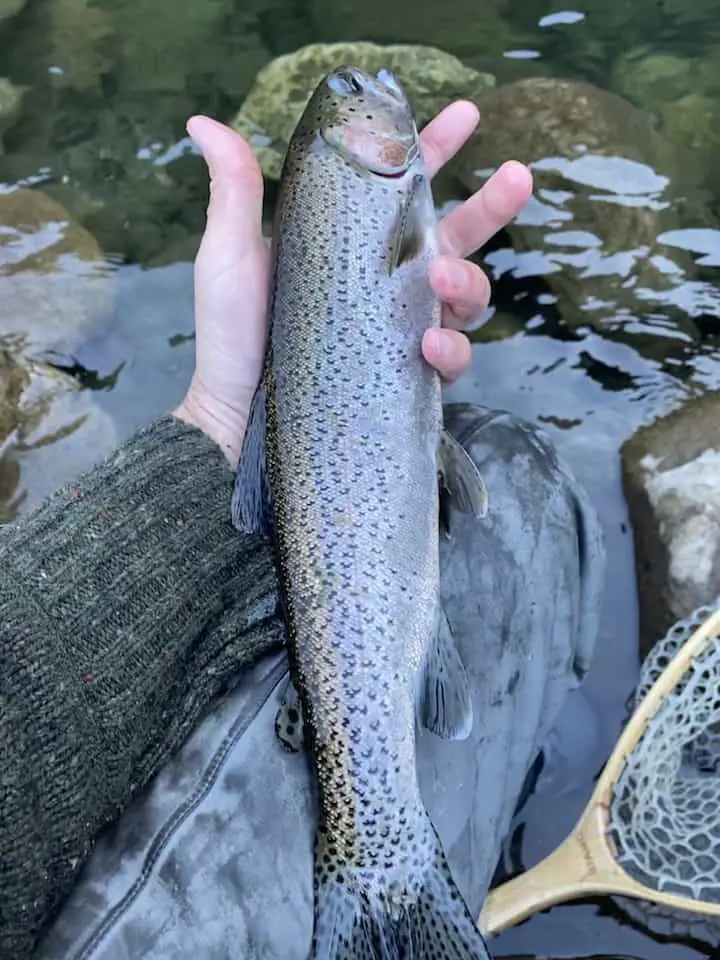
- Sunny days certainly don’t deter me from fly fishing, but usually there aren’t as many bugs on the water (hatches). Insects hatch less frequently when it’s bright out because they can dessicate (dry out) faster. With that said, many folks will tell you that trout won’t rise in the direct sunlight, but that’s grossly misleading. I catch rising trout in bright sunlight very, very regularly throughout the year.
- I always try to stay as late as possible when I’m fly fishing during wintertime because some of the best fishing often happens around sunset. Trout seem more active and hatches can accelerate. But, I always see other fly anglers heading home around 3pm, it’s like clockwork. Staying late can make all the difference.
Here’s one of many solid brown trout I caught in February on dry flies, mostly midges, sized 20-24.
The Best Winter Fly Patterns
- Blue winged olives (BWOs) hatch regularly throughout winter. When you see them flying around, tie-on a BWO dry fly pattern. I’d recommend starting with size 18-20. Here’s an article I wrote explaining BWO fly fishing.
- Midges are even more prolific than blue winged olives during winter, and when you see them on the water, tie on a midge dry fly pattern. Again, I’d start with a size 20 and go smaller from there.
- A griffith’s gnat dry fly can be a really productive dry fly during the winter. They tend to imitate a midge cluster. This is when midges get bunched together on the surface of the water. Trout key-in on these because it’s a nice easy meal.
- No winter fly angler should be without pheasant tail nymphs. These come in beadhead and non-beadhead versions. I’m not sure if there’s a fly oin existence that’s caught more trout than this pattern. Whether you’re fly fishing during winter, spring, summer, or fall, get some of these. I’d recommend sizes 18-22. My personal preference is the flashback version.
- The zebra midge nymph is a must-have. This is a beadhead nymph that has proven to be super effective for me during the winter. Sizes 18-20 have proven most effective for me. The disco midge is an honorable mention.
- If youre into streamers, the woolly bugger is tough to beat. These come in beadhead and non-beadhead versions, but I’d recommend the beadhead since it’ll help you get down to the fish. Sizes 14-16 are most productive for me. Use a slower retrieve and try to get close to the bottom.
- If you’re into ice fishing, check out my article on the best ice fishing flies.
- One fly I like a lot is the beadhead soft hackle pheasant tail nymph. Now, this is different than a standard pheasant tail. This is technically a wet fly, but I like to use it like a streamer. It’s been really productive for me during the winter. I use a size 16 most of the time.
- During the winter, use flies with darker colors like black, brown, and olive. Avoid bright, flashy colors.
- If you’re fishing heavily-pressured rivers, try coloring the beadhead black. I think some trout learn to be apprehensive of shiny, brass-colored beads drifting through the water.
As promised, here’s a picture of a winter midge I picked-up from the water’s surface in February. They look a little like mosquitos.
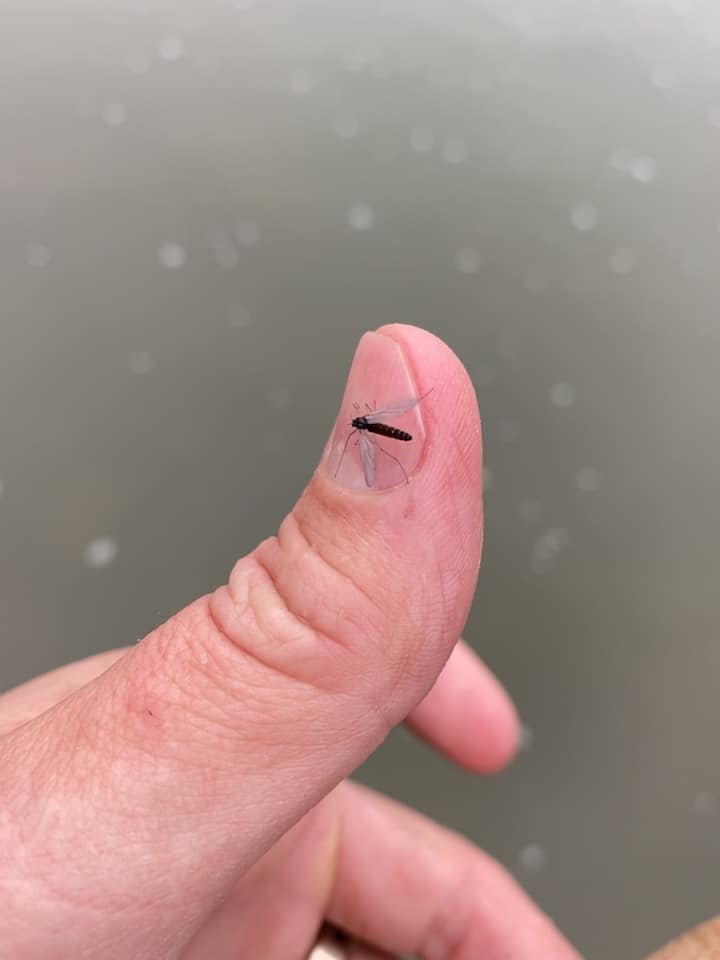
And here’s a picture of a blue winged olive mayfly that I also picked-up from the water’s surface, but in January. A beautiful and graceful insect.
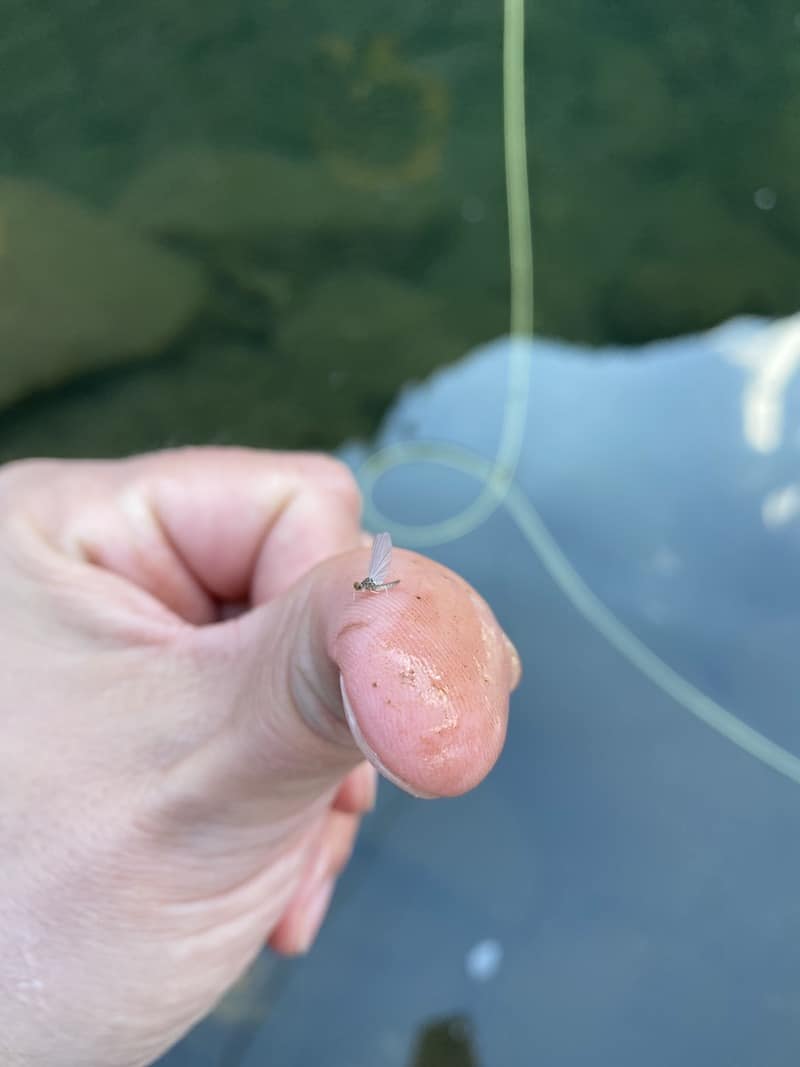
Winter Fly Fishing Gear
- Gloves sound great when it’s cold, but they have two big negatives. Firstly, they’ll get wet, and stay wet. Secondly, wearing a glove detracts from your feel when casting your rod–it mutes the connection between your hand and your fly rod. I don’t ever wear gloves.
- Wool is your friend during winter. Nothing can beat it. Wool socks, wool hat, wool trousers underneather your waders, wool sweater, I’m all about wool. I won’t bore you with the scientific reasons wool is so great for staying warm and dry, but please take my word for it. Merino wool is the best in my experience.
- Wear a ballcap underneath your winter hat or hood. You’ll be glad you did. The visor helps greatly in seeing the water’s surface when there’s glare.
- Hand warmers are of little use in my experience. Same for foot warmers, which I’ve tried many times.
- Wear metal studs in your wading boots. Felt-soles freeze and are a real hassle.
- Sealed drag fly reels will freeze-up much less often than click and pawl reels.
Here’s a big, beautiful rainbow trout I landed in January–one of several that day–on tiny dry flies.
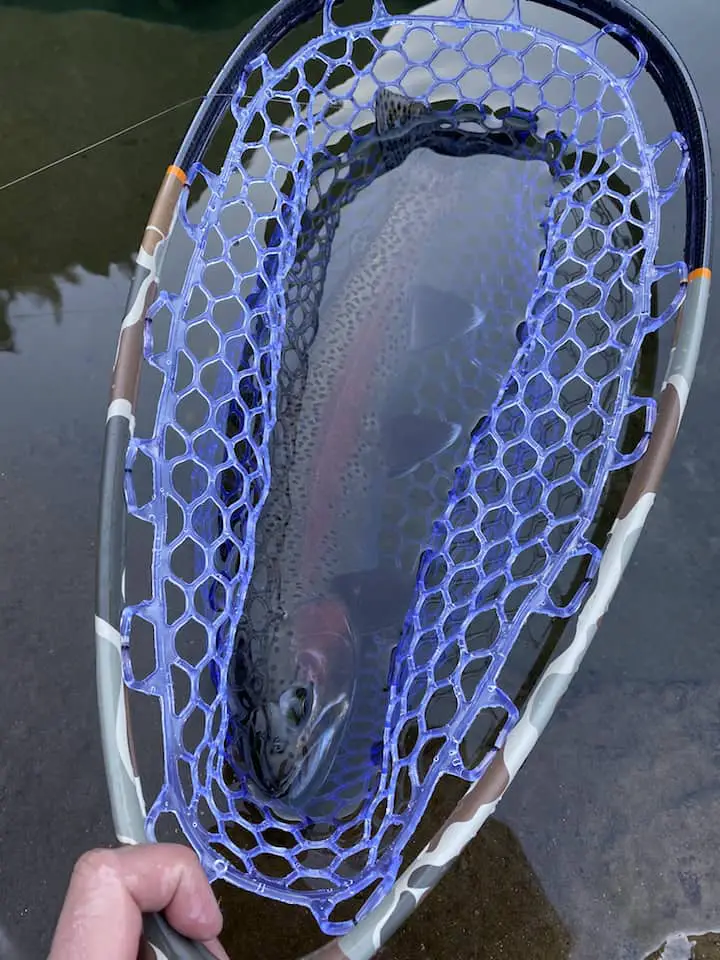
Winter Fishing Safety
- Don’t venture too far from your vehicle when you’re fly fishing in winter. If you take a spill into the frigid river, which will eventually happen if you fish often enough, you’re not going to want to walk a mile in freezing temperatures to get back to your vehicle. Hypothermia can set in faster than you might think.
- Watch for drifting ice sheets. These can be really dangerous if you’re facing downriver. Here’s an article I wrote on tips for safe wading.
- It might be tempting to walk on solid ice that extends over the river, especially when trout are rising alongside it in open water, but don’t play that game.
- I rarely take pictures of the fish I net–unless there’s something noteworthy or exceptional about the situation. During the winter, make sure you don’t keep your trout out of the water too long. Their gill filaments can actually freeze relatively quickly.
Here’s a midge that I noticed after taking a picture of a bruiser rainbow I’d caught. It’s not uncommon to see insects on ice during the winter.
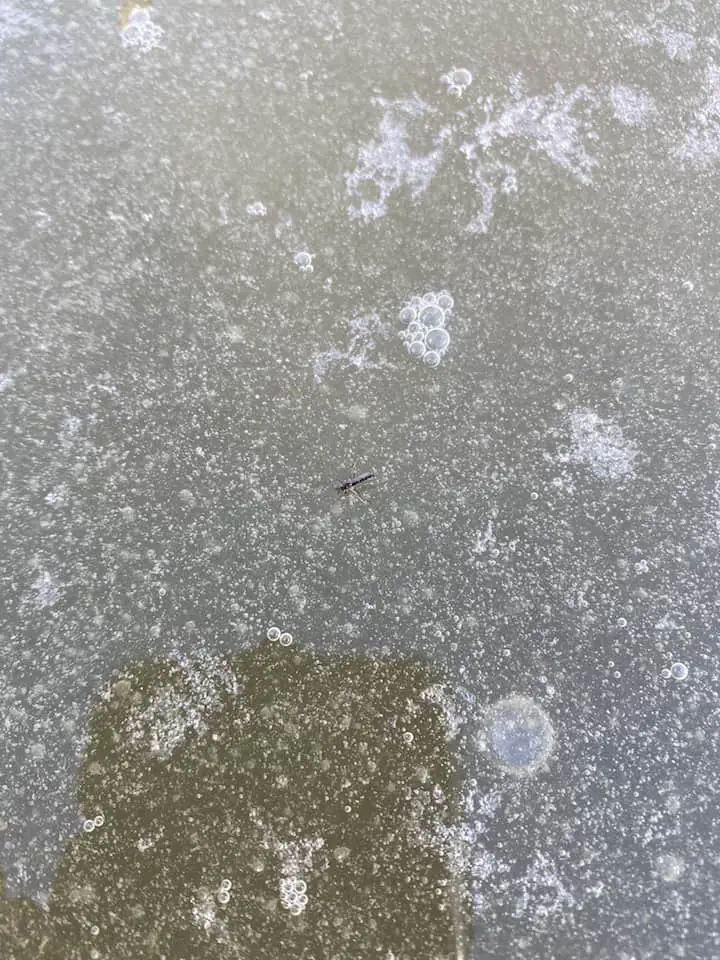
Summary
Here’s one thing I can promise you: when you’re actually catching trout in the wintertime, you won’t feel the cold or the wind–not one bit. Along those lines, I hope I’ve helped equip you to be successful the next time you try fly fishing in December, January, February, and March.
Two weeks ago, in mid-February, I hooked into 19 trout on dry flies, landing 16 of them. Winter can be a fly angler’s utopia, and with noticeably fewer crowds, you’ll likely have the river to yourself.
Dry flies, nymphs, and streamers can all work very well during the winter, so get out there and start experimenting. Learn what works on your local rivers. It’ll take some work, but that shouldn’t stop you. You’re a fly angler because you embrace a challenge.
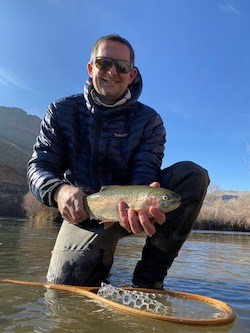
About the Author
My name's Sam and I'm a fly fishing enthusiast just like you. I get out onto the water 80+ times each year, whether it's blazing hot or snow is falling. I enjoy chasing everything from brown trout to snook, and exploring new waters is something I savor. My goal is to discover something new each time I hit the water. Along those lines, I record everything I learn in my fly fishing journal so I can share it with you.
Follow me on Instagram , YouTube, and Facebook to see pictures and videos of my catches and other fishing adventures!
